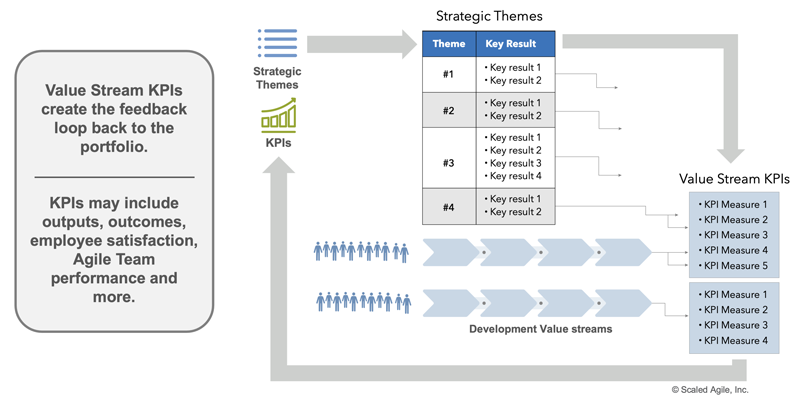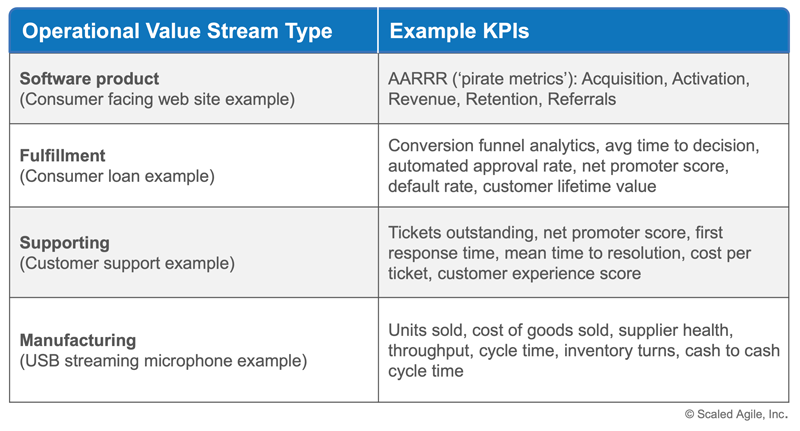[what is needed is] “a principle of management that will give full scope to individual strength and responsibility and at the same time give common direction of vision and effort, establish teamwork and harmonize the goals of the individual with the commonwealth.”
—Peter Drucker (as excerpted from Measure What Matters [1], by John Doerr)
Value Stream KPIs
Value Stream Key Performance Indicators (KPIs) are the quantifiable measures used to evaluate how a value stream is performing against its forecasted business outcomes.Development Value Stream KPIs close the feedback loop that travels from:
- Strategic Themes through the lean budgeting process funding the value streams
- Through the Portfolio Kanban that establishes key portfolio initiatives
- Forward to measuring the business outcomes the investments were intended to create
Details
Principle #9 – Decentralize decision-making is a critical mindset for operating a SAFe enterprise. Applying this principle greatly rewards the business and its employees; however, it also challenges many traditional aspects of governance and operations. For example, the SAFe approach to Lean Budgeting simplifies financial management, empowers decentralized decision-making, and increases the flow of value through the enterprise to its customers. But how does the enterprise know those decisions are appropriately informed?
The answer is to create clear targets regarding what outcomes are expected, rather than to identify and manage the projects or tasks people need to perform to achieve them. To that end, each Development Value Stream defines a set of quantifiable measurement criteria, or Key Performance Indicators (KPIs) that can evaluate the ongoing investment for that value stream.
Strategic Themes Inform Value Stream KPIs
Each portfolio has a set of strategic themes that connect the Enterprise strategy to a specific Portfolio Vision. As such, they reflect the intended business outcomes the strategy, investment, and portfolio vision. As described in that article, strategic themes are best formulated as Objective and Key Results (OKR). This means that those key results define the primary, high-level business outcomes. The full set of outcomes reflects the overall business intent of that portfolio.
Given that, the key results must be delivered or supported by the portfolio development value streams, individually or in concert. This means that key results are likely to appear directly or indirectly as KPIs, as Figure 1 illustrates.

Some relationships from key results to KPIs are one-to-one. In other words, a specific value stream key result drives a specific KPI. Some are one to many, meaning that they directly drive or influence multiple, specific KPIs. Other relationships, however, are more amorphous; they may cross values streams, aggregate results of value stream coordination, or influence outcomes in some other way that does not directly drive a specific KPI.
Local Context Informs Development Value Stream KPIs
In addition, as Figure 1 illustrates, while OKRs are indeed significant concerns of the portfolio, each value stream also has its own local context. This means that some value stream KPIs are derived locally and are instead specific to the business objectives of that value stream. As a result, they will not trace directly to a strategic theme key result.
While SAFe’s primary focus is development value streams, these value streams serve one purpose: enabling the enterprise’s Operational Value Streams (OVS) to achieve targeted business outcomes. Therefore, the operational value streams also inform some of the local context KPIs for development value streams. These are typically different from value stream to value stream within a portfolio. For example:
- Some development value streams support revenue generation directly, making revenue a likely KPI. Other metrics—such as operating margin, market share, or solution usage—may provide additional insights.
- Other development value streams are emerging offerings. In this case, although return on investment would seem to be an obvious KPI choice, ROI is a lagging economic measure and may not be useful for measuring early-stage investment. Instead, non-financial, Innovation Accounting KPIs offer faster feedback.
- Some development value streams are primarily cost centers, serving internal operational value streams. In this case, other measures may be more relevant, including:
- User and business owner satisfaction
- Absolute costs and ratios for new development versus sustainment
- Net promoter score
- Output measures like feature cycle time, rather than outcome measures
Measuring What Matters: Tips and Examples
As we’ve indicated, KPIs are specific to the type of development value stream, so only fairly general guidance can be provided. The following tips provide some aids for establishing KPIs:
- Good KPIs focus on objective, quantitative, and measurable desired business outcomes
- Development value stream KPIs often include high-level process measures such as speed, quality, flow, and process improvement assessments (see Metrics for more)
- Strategic theme OKRs are primary sources of development value stream KPIs
- Trends and ratios often provide more information than absolute numbers
- Don’t bury yourself in data: 4-7 KPI’s per value stream is typically sufficient
But as we have implied, most of the value of development value stream KPIs are driven by the business results development teams and ARTs help deliver. To that end, the most meaningful KPIs are those associated with the operational value streams they support. Table 1 highlights some example KPIs that could be readily shared with four primary types of operational value streams.

Closing the Loop on Lean Budgeting
Development Value stream KPIs play a critical role in aligning strategy and execution in SAFe. While Agile teams are empowered and responsible for implementing the work, investment strategy rests with those responsible for assuring that sufficient capital is available to pay the people doing the work.
Money must also be available to pay suppliers, general and administrative costs, and, indeed, all the costs associated with a portfolio of investments. That includes an obligation to provide an appropriate return to economic stakeholders. Strategy formulation and allocation of the enterprise’s treasury is a critical, financial responsibility. Moreover, it’s an ethical and moral one that cannot be left to chance or delegated beyond the point of responsibility and accountability.
Therefore, portfolio investments must be planned, allocated, and tracked, no matter the type or size of the business. That is the role of Lean Portfolio Management (LPM), which benefits greatly from value stream KPIs.
Learn More
[1] Doerr, John. Measure What Matters. Penguin Publishing Group, 2018.
Last updated: 27 September 2021





